
When Chinese tea lovers speak of “rock rhyme”—the stony, mineral whisper that lingers after swallowing an oolong—they are quoting Wuyi Da Hong Pao, the scarlet-robed sovereign of the cliff gardens in northern Fujian. To the international palate, Da Hong Pao offers a passport to China’s most dramatic tea landscape: a UNESCO dual heritage site where vertical gorges, running mist and 360-million-year-old Danxia sandstone shape both the terror and the lore of a tea whose auction price once exceeded gold. This article walks you from Tang-dynasty legend to twenty-first-century teapot, decoding why a single gram of authentic mother-tree Da Hong Pao can sell for one thousand U.S. dollars, yet everyday “commodity” Da Hong Pao remains the friendly gateway into Chinese oolong culture.
-
Origin Myth and Imperial Chronicle
The name “Big Red Robe” first appears in a Ming-era stele near the Nine-Dragon Gorge. Folklore claims that a Ming emperor’s mother was cured of a lingering illness by monks who brewed leaves plucked from six ancient bushes clinging to Tianxin Cliff. In gratitude, the emperor sent official red silk robes to drape the bushes, hence the name. Qing records list the tea as tribute, carried on horseback from Wuyi’s “Three Pits and Two Gullies” to Beijing, a three-month journey that imprinted the leaves with additional slow oxidation inside bamboo cylinders. After 1949, the mother trees were nationalised; since 2006, plucking from them has been banned by presidential decree, making any pre-ban harvest a museum relic. -
Micro-Terroir: Why Rocks Sing in the Throat
Wuyi’s Danxia landform alternates iron-rich sandstone with soft shale. Daytime cliff faces reach 45 °C, while night temperature plummets to 18 °C; the 15-degree swing forces the tea bush to convert starches into aromatic amino acids. Thin topsoil forces roots to probe crevices two metres deep, absorbing minerals that later translate into the celebrated “yan yun” (rock rhyme), a tactile finish reminiscent of wet slate, cinnamon and river stone. Four micro-valleys—Huiyuan, Niulan, Daoying and Liuxiang—produce the most sought-after “Zhengyan” (core cliff) leaf, while surrounding “Banyan” (half-cliff) and “Zhouyan” (river-bank) gardens offer affordable, still fragrant, interpretations. -
Cultivar Constellation
Da Hong Pao is both a historic brand and a blend of four indigenous Wuyi cultivars:
- Qi Dan: the closest genetic match to the mother trees, small leaf, orchid nose.
- Bei Dou: cold-resistant, planted on higher ledges, peppery finish.
- Que She: “sparrow tongue,” high floral top note, pale liquor.
- Tieluohan: “Iron Arhat,” thick leaf, deep charcoal bass.
Modern clonal propagation (garden cuttings) allows farmers to re-create the mother-tree flavour profile without violating conservation law, leading to the term “purebred Da Hong Pao.” In contrast, “commodity” or “matching” Da Hong Pao is a skillful blend of these four cultivars with other Wuyi bushes such as Rou Gui and Shui Xian to achieve price-accessible consistency.
- Craft: The Eight-Stage Cliff Ballet
Harvest occurs only in late April, when three half-mature leaves and a bud still carry the spring dew. The eight stages unfold within twenty-four hours:
a. Pluck by rope: pickers abseil cliffs at dawn to avoid midday heat.
b. Sun-wither: leaves are spread on bamboo trays for 30 minutes of gentle UV, initiating enzymatic oxidation.
c. Indoor wither & shake: the “green room” is kept at 26 °C and 65 % RH; every 45 minutes the leaves are tossed in rattan drums to bruise edges while keeping the centre intact—critical for partial oxidation.
d. Kill-green: a 280 °C wok roast for 90 seconds halts oxidation at 40 %, preserving the green core.
e. Rolling: cloth-wrapped leaves are twisted under foot pressure, releasing jasmine-like aromatics.
f. Initial roast: 100 °C for two hours removes residual moisture.
g